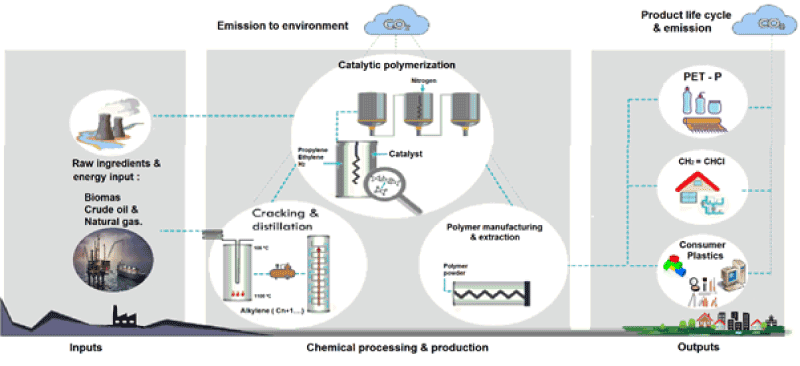Plastics, particularly in form of micro/nanoplastics are everywhere around us and their sustainable disposal and recycling is a fundamental problem for environmental safety [1]. In early human history plastic was a resource that occurred naturally, for example as sap from a gum tree. However, in recent times plastic is produced synthetically from fossil fuels. The fossil fuel is refined into ethane and propane, which in a process called cracking produce ethylene and propylene, respectively. These substances are combined with a catalyst to form polymers, which are easy to shape and mold to the needed form.
The problem of humans producing plastic waste is not new. Especially single use plastics, which make up about 40% of our plastic waste, pose a large problem to the environment. Approximately eight million tons of plastic waste is dumped into the sea yearly, where the sun and the waves degrade the plastic material into tiny fragments called microplastics. These fragments range from a size of 50 to 500 micrometers, which is about the width of a human hair. It is well known that these microplastics affect marine life and other animals; however, until recently scientists were unsure whether remains of microplastics can be also found in humans.
A research group recently reported that in fact, microplastics are consumed by humans and can be found in their feces [2]. In this study participants were asked to record their eating and drinking habits for a week and then their excrement were studied for ten different types of plastics. Every single feces sample contained microplastics. Two of the few ways the participants encountered plastics was through drinking out bottles made of polyethylene terephathalate (PET), and eating food that was packaged using plastic materials [3]. However, the investigators are not yet sure if the bottles or the plastic packaging are really the sources of the microplastics found in the excrement. For example, the microplastics consumed could have also been originating from their clothing, furniture or from ambient air [4].
The results reported in this study actually have been expected by many other scientists. It was previously known that microplastics reside in drinking water, beer, table salt, and seafood. Researchers were even able to show that the consumed amount of microplastics floating in the air is non-negligible [5]. Furthermore, we also may incorporate microplastics from cosmetics and hygiene products, like toothpastes, body washes and eye liners, since they contain microplastics as a cheap alternative to natural ingredients. Another reason for expecting plastics in human bodies is that microplastics have been observed in birds and marine animals several times before. Microplastics affect all types of marine life regardless of size. It was shown that these plastics have entered the system of more than 114 aquatic species and potentially harm the reproductive system as well as the liver of these animals [6].

Figure 1. The key industrial chain for plastics production spanning polymer and chemical industry primarily using crude oil and essentials. Various byproducts at extraction and polymer processing yield plastics, the upstream resource which upon incineration or decomposition turns into micro/nanopalstics
Whether microplastics cause any harm to humans remains ambiguous. The question of whether or not microplastics enter the bloodstream, lymphatic system, or the liver remains as yet unanswered. Nonetheless it is currently of great concern that microplastics might really enter the human body and become bioavailable, an issue possibly be associated with serious health effects. To demonstrate or exclude any harmful effects to humans much more studies have to be done to shed more light onto the origins of microplastics, the way and levels of human exposure, its biokinetics and possible toxicological effects in the human body. Certainly, one principal way to lower any possible risks for humans is to reduce the amount of plastics entering the environment in the first place. Attractive deposition systems could be used to ban littering and effective recycling processes would be instrumental to achieve the highest recycling quota possible and to reduce both environmental and human exposure.
- Eriksen M, Thiel M, Prindiville M, Kiessling T (2018) Microplastic: What Are the Solutions? In Freshwater Microplastics : Emerging Environmental Contaminants, Eds. Springer International Publishing: Cham, pp: 273-298.
- Schwabl P, Köppel S, Königshofer P, Bucsics T, Trauner M, et al. (2019) Detection of various microplastics in human stool: a prospective case series. Ann internal med.
- Dwivedi C, Pandey I, Misra V, Giulbudagian M, Jungnickel H, et al. (2018) The prospective role of nanobiotechnology in food and food packaging products. Integr Food Nutr Metab.
- Singh AV, Laux P, Luch A, Sudrik C, Wiehr S, et al. (2019) Review of emerging concepts in nanotoxicology: opportunities and challenges for safer nanomaterial design. Toxicology Mechanisms and Methods 29: 378-387.
- Thompson RC, Olsen Y, Mitchell RP, Davis A, Rowland SJ, et al. (2004) Lost at Sea: Where Is All the Plastic. Science 304: 838-838.
- Barboza LGA, Dick Vethaak A, Lavorante BRBO, Lundebye AK, Guilhermino L (2018) Marine microplastic debris: An emerging issue for food security, food safety and human health. Marine Pollution Bulletin 133: 336-348.

